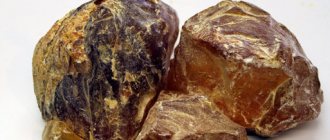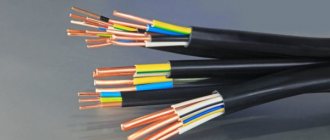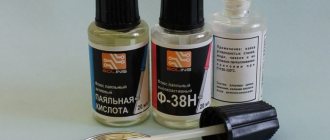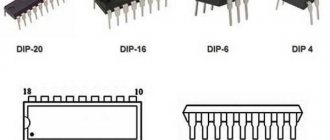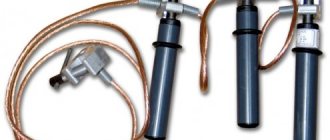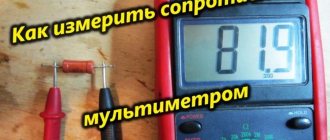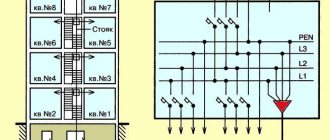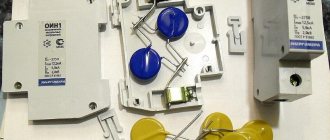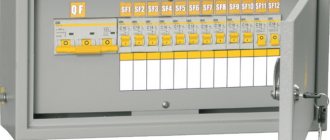Soldering copper
At home, it is preferable to use soldering of copper products; this option is the simplest and fastest compared to cooking.
In addition, you do not need special equipment to carry out the fastening. If all the rules and conditions of the technological process are observed, a strong and reliable connection of elements can be obtained, increasing resistance to various loads. To ensure that soldering at home does not cause difficulties, first of all you need to take care of the basic tools that will be involved in this process:
- pipe cutter;
- chamfer;
- pipe expander;
- steel brush;
- steel brush;
- solder;
- burner or hair dryer.
For a tubular device, a method is used when the element is immersed in a composition of salt and solder. Salt acts as a heat source and replaces the functions of flux. Therefore, additional flux is not needed.
In addition to this method, there are several other soldering options that deserve attention.
Soldering copper
Methods for soldering stainless steel with copper
In order to make a connection of this kind, you can use several different methods. Oddly enough, they differ not in the type of solder, but in the tool with which the procedure will be performed. Most often, preference is given to connecting using a soldering iron or a gas torch.
The soldering iron is most often used when working with small parts. With its help, this is quite convenient to do, largely due to the fact that during operation the tool does not heat up much, which reduces the risk of burning through the part. But there is also a downside to this method: the soldering iron is significantly inferior to the torch in power, which makes processing parts made of hard metals simply impossible. In addition, it is difficult to process large surfaces with a soldering iron, since it will take quite a long time; most likely, by the end of the work, the flux will already oxidize.
The gas burner is used much more often. It can be used not only for soldering stainless steel with copper, but also with brass, nickel and other solders. A gas burner allows you to process fairly large surfaces, creating connections with a high level of tightness. The high speed of operation does not allow the flux to oxidize.
Classification of copper products
Copper pipes in Europe are mainly metric; 6, 8, 10, 12, 15, 22, 28, 42 and 48 mm are also found in larger diameters, but they can also be inch:
| inches | mm |
| 1/4 | 6.35 x 0.8 |
| 3/8 | 9.52 x 0.8 |
| 1/2 | 12.7 x 0.8 |
| 5/8 | 15.9 x 0.8 |
| 3/4 | 19.1 x 0.8-0.9 |
Copper marking in Russian marks: the letter “M” is used to denote copper. Next are numbers showing the degree of purity in% (00 - highly pure, 0 - pure, 1, 2, 3 - technically pure). The last element of the marking is a letter indicating the method of copper production: (k - cathode, y - cathode remelted, b - oxygen-free, p - deoxidized, f - deoxidized with phosphorus).
| Copper grade | M00 | M0 | M1 | M2 | M3 |
| Purity | 99,99 | 99,95 | 99,90 | 99,70 | 99,50 |
Copper grades M1p, M2p and M3p, with a total impurity content identical to copper grades M, M2 and M3, differ from them in that they are more completely deoxidized and the oxygen content in them is reduced from 0.05 - 0.08% to 0. 01%. Therefore, they additionally contain from 0.002% to 0.012% phosphorus. The M1f copper grade differs from M1r in an even greater amount of phosphorus from 0.012% to 0.04%, for greater deoxidation and, accordingly, a complete absence of oxygen.
CHEMICAL COMPOSITION OF COPPER ACCORDING TO GOST 859 (%)
| Copper grade | Cu+Ag (%) | Impurities, no more (%) | ||||||||||
| Bi | Sb | As | Fe | Ni | Pb | Sn | S | Zn | O | P | ||
| M1f | 99,90 | 0,001 | 0,002 | 0,002 | 0,005 | 0,002 | 0,005 | 0,002 | 0,005 | 0,005 | — | 0,04 |
| M1r | 99,90 | 0,001 | 0,002 | 0,002 | 0,005 | 0,002 | 0,005 | 0,002 | 0,005 | 0,005 | 0,01 | 0,012 |
| M1 | 99,90 | 0,001 | 0,002 | 0,002 | 0,005 | 0,002 | 0,005 | 0,002 | 0,004 | 0,004 | 0,05 | — |
| M2 | 99,70 | 0,002 | 0,005 | 0,01 | 0,05 | 0,2 | 0,01 | 0,05 | 0,01 | — | 0,07 | — |
| M3 | 99,50 | 0,003 | 0,05 | 0,01 | 0,05 | 0,02 | 0,05 | 0,05 | 0,01 | — | 0,08 | — |
The use of various grades of copper in plumbing products is determined by GOST 52318, and in Europe - EN 1057. In construction products: GOST 495-92, in Europe - EN 1172. Typically, water pipes contain 99.90 copper and are excellent for home brewing purposes.
Soldering iron and solder
Soldering irons are traditionally used for soldering copper wires. There are several types of them, including electric and gas. Soldering of copper wires is carried out using an electric soldering iron with a copper tip. This tool consists of a copper rod, sometimes nickel plated, that is mounted in a heating element housing.
The heating element operates on direct or alternating current. The supply voltage can vary from 12 to 220 V. For soldering copper wires of electrical wiring in the house, the most common soldering iron with a power of 60 W is suitable. If you need to solder thin wires of an electrical appliance, then a less powerful tool will do. It is important that it heats the copper material well and melts the solder.
To ensure high soldering quality and joint strength, it is necessary to remain still while the molten solder cools. You can hold the wires with your hands, but it is more convenient to use tweezers or clamps.
Tin-lead solder is used for soldering copper wires. Most often this is POS-61, but you can also take POS-40. The marking indicates the composition - tin-lead solder with a tin content of 61%.
Solder is usually produced in rods with a diameter of about 8 mm or in the form of solder wire with a diameter of 2 mm. General purpose solder is often used for soldering copper wires, which looks like a hollow tube of tin-lead alloy. Inside such a tube there is flux powder.
Do not pay attention to the fact that the burner in the photo is professional. I prefer to solder copper with just such a gas torch (with a cylinder). We take wire 1 mm thick or thicker. We prepare pieces of copper-phosphorus solder in advance. You will understand what dimensions are needed for the frame after you look at the photos. It all depends on the volume of additional elements that you will attach to the frame. First solder the frame circumference, then solder the jumpers. You can solder several joints at once. We do everything carefully - do not “burn” the wire itself. The solder should spread evenly along the wire, filling the joint.
After annealing, copper becomes soft. To give the copper some rigidity, flatten the entire frame a little with a hammer on an anvil. You can process the frame with a file and polish the copper.
I prepared the spirals for this decoration in advance. Watch the video.
Next, we act according to the plan (if there is one, of course).
We limited the edges of the cabochon with a spiral. Next, we secure the cabochon with braid so that it does not fall out.
Watch the video with examples of braids.
As a result, we get a pendant like this.
Don't relax - we're not done yet. Let's look at another example. At first, everything was the same as before.
Immediately fasten the cabochon with 1 mm thick wire to the frame. We fix the cabochon in the right place.
An unexpected decision. Yes!?
Well, then we give free rein to our imagination.
I used “old” spiral scraps.
Well, I had a blast.
Cool, yeah!? I'm not talking about pendants, but about the method of assembly with the frame!
Watch video tutorials on soldering
I patinated, polished and then varnished the pendants (copper). To patina (aging) copper, you can use regular ammonia, which is sold in pharmacies. Pour the ammonia into the jar and hang the product OVER. ammonia solution.
You can also use special universal solutions for blackening.
For polishing, we use a machine grinder (you can use a screwdriver or drill) with attachments. We use polishing pastes.
Copper will darken over time. To avoid this, you can coat the entire product with a special Tsapon varnish.
The products are ready. You can wear, give or SELL! Read where and how to sell handmade jewelry on my website Making money with handicrafts!
Pin the Pin below as a bookmark to your Pinterest board.
How do you like the master class!? Did you like it!? Don't be lazy, share with your friends on social media. networks. I will be grateful.
Share link:
Valeriy Vorobev
“It’s not clever to make an expensive thing if gold itself has a price. Make something out of simple copper that will make everyone around you wonder. Then I will believe that you are a master.” — From a Russian folk tale.
During the soldering process, it is imperative to follow a clear sequence of operations.
- The metal surface is cleaned of dirt and oxides, and then degreased. To do this, metal brushes, various abrasives and solvents are used. Alternatively, alcohol.
- The details are carefully recorded. If we are talking about soldering pipes, it is recommended to fix them using special clamps. This is important not only when making butt joints, but also when pipes are inserted into one another.
- The metal warms up properly. Only after this, if necessary, is flux applied to its surface. The easiest way to do this is with a brush.
- It is impossible to distribute pre-crushed solder over the surface of pipes. Therefore, it should be applied gradually, increasing the mass and evenly distributing the composition over the surface of the part. You should ensure that the material does not stick to the tip by cleaning the tool in a timely manner. Care must be taken to ensure that there are no gaps left and that the seam is sealed.
Pipes or other copper parts connected in this way will be able to withstand significant loads and will last a long time.
Soldering tools
Before starting work, you need to prepare special tools and devices for soldering copper connections. You will need:
- Gas or oxygen torch for soldering copper (with nitrogen, acetate, etc.);
- Solder (for capillary soldering according to GOST R 52955-2008);
- A brush (hard, but not metal) and abrasive paper for stripping copper connections;
- Fittings or other connected elements;
- Soldering flux.
It should be noted that if the work is done on pipe connections, then you may also need a chamfer, an expander, or a special cutting device. All of these fixtures can be found at a professional plumber so you don't have to buy them.
Photo - burner
Burners for copper are: professional (for working with hard solders), for heating pipes and soldering with soft pastes, semi-professional or combined. There are also special hair dryers that are used for soft soldering. They allow you to quickly heat the joint at temperatures up to 650 degrees.
- Solid. They are represented by rods of a certain diameter, which is selected based on a certain gap when connecting. It is used when connecting copper and iron in water supply systems, gas supply and air conditioning systems. This solder can be with phosphorus or silver;
Photo - hard solder - Soft ones can be either in the form of paste or thin wire up to 3 mm in diameter. They are produced with lead and tin. Also sometimes the process is carried out with orthophosphoric acid.
Also, to join copper alloys, it is necessary to use flux. It performs several useful functions: it promotes better spreading of solder over the metal, protects the processing area from an oxygen film, and cleans the seam from oxide. Fluxes come with borax (for various high-temperature solders), used for medium-melting compounds of gold, copper, bronze, cast iron, and stainless steel. Outwardly, they look like a paste and are applied with a special brush.
Photo - flux paste
Brushes and abrasive sheets (sandpaper) are needed to remove solder residues from the seam after finishing work. Fittings are selected based on the required connections (they can be branching, corner, curved, etc.).
Photo - soldering iron
Let's look at how copper pipe soldering is done with your own hands:
- Any technology involves pipe preparation. You will need to cut the communication to the desired size and trim the ends with a bevel gun. This is necessary so that the next element is not damaged during connection and the maximum rigid adhesion of the parts is obtained;
- Soldering flux is applied to the edge of the copper pipe, and it is also applied to the fitting or other pipe. Afterwards you need to carefully insert the communications into each other. If soldering is done with self-fluxing solder or an electrode, then flux does not need to be used;
- The selected solder is inserted into the joint. It should be noted that if a paste is used, it must be applied after the flux. Under the influence of a certain temperature, the substance will begin to melt, filling the free space in the pipe. A very important point: the solder cannot be exposed to direct fire, it should melt only from the heat of the heated pipe;
Photo - soldering with solder - If tinning is used, then the flux and solder are applied in a very thin layer, otherwise an unsightly volumetric seam will form at the soldering site. If locks or radio components (usb, contacts) are repaired, this may disrupt the operation of the element;
- After heating is completed, the tool is removed. At this moment, the pipe cannot be moved - the connection is still too plastic, and turning the metal bends can damage the fastening. Copper pipes cool naturally;
- All that remains is to remove the remaining solder or flux with a brush, abrasive paper or brush. It is not recommended to overcool the joint during the first 24 hours, when the metal solidification process is not completed.
Photo - after cleaning
What tools and materials are needed
In industrial production, various technologies for connecting copper parts are used. However, this procedure can be performed at home. To do this, you need to prepare tools and equipment in advance:
- flux;
- set of brushes, metal brush;
- solder;
- manual or automatic pipe cutting apparatus;
- soldering iron, gas burner.
The power of the equipment is selected depending on the melting temperature of consumables.
Types of consumables
Flux is necessary to protect the joint of parts from the formation of an oxide film. In addition to this, flux helps the solder spread over the future seam. Tin is most often used as solder because it has a low melting point.
Silver is a good connecting material for soldering, but it is expensive. Because of this, craftsmen dilute it with tin and a small amount of copper. Among the solders used, there are two types of materials: soft and hard compounds.
Soft
Such consumables are used to connect water pipes. In this case, the diameter of the pipes that need to be connected can reach 10 cm. Soldering copper with soft solder is used in cases where the connected parts will not heat above 130 degrees Celsius. Soft consumables include:
- lead and tin alloys;
- compounds with a low percentage of tin;
- special compounds.
According to buyers, the most popular is an alloy of tin and copper. It is excellent for joining copper products. In addition, it is economically consumed.
Solid
Soldering copper with solid compounds is possible if it is necessary to make a strong seam that will withstand environmental factors. These include:
- alloy of copper and zinc;
- homogeneous copper;
- a compound of copper and phosphorus.
There are two types of solid compositions: refractory and low-melting. To make a strong connection, it is recommended to use a multi-component composition.
Some types of solders
Cadmium solders when soldering copper and steel require certain skills to work with them. Because the manufacturability of these materials is lower than that of previous ones.
It should be noted that such a connection is heat-resistant (up to +350 ℃), but not cold-resistant. In addition, a cadmium alloy joint will not be very strong.
Zinc solder materials are rarely used for soldering copper because the metal itself quickly dissolves into the solder material. This weakens the joint, hence the low tensile strength - up to 15 MPa.
Zinc solders alloyed with silver or copper also have low fluidity. Although these materials are doped with cadmium or tin, they have good fluidity, but the strength of the compound itself decreases greatly.
Copper-phosphorus grades with the addition of silver are a good option for soldering. The connection can withstand high loads, up to 300 MPa, and temperatures up to +800 ℃. But solder metal bonded to copper is not ductile. This means that it has low bending strength.
Silver solder materials have proven themselves well in high-temperature copper soldering conditions. True, they show their qualities if soldering is carried out with acetylene or in special furnaces where corrosive fluxes are used.
Solders with a high silver content are used in the process of joining copper blanks in a vacuum or when heated with argon. If the process is carried out under pressure, then either foil (silver) or silver coating is used for the connection.
Solder materials with a high copper content and a low silver content are used rarely and in exceptional cases. Because it is a refractory alloy that requires high heating temperature.
As for pure lead solders, the connections made with them are not strong enough, but they have high ductility. For example, such joints after soldering can be bent up to an angle of 130°, and in tension they can withstand up to 140 MPa.
general information
Before you start soldering copper, you need to carefully study its technique. Trying to immediately use a soldering iron or other equipment will definitely not lead to anything good. Responsible specialists must study thematic GOSTs:
- 17325-79 (basic definitions and terms);
- 17349-79 (key methods and methods);
- 19249-73 (types of connections obtained by soldering);
- 859-78 (main copper grades);
- 19250-73 (types of soldering fluxes);
- 7219-83 (technical parameters of household soldering irons).
Soldering copper is done in two key ways. With the high-temperature method, heating is carried out up to 900 degrees. This approach gives very good results on high pressure pipes. Of course, this cannot be done without special materials - ordinary solder will not cope with this task. And ideally, a different type of solder should be selected for each specific task.
From an engineering point of view, soldering is a very complex physical and chemical process in which a permanent connection is achieved. Part of the part will melt under the influence of a heated substance, and such particular processes occur as:
- wetting;
- spreading;
- gap saturation;
- crystallization.
How strong the joint will be depends on the chemical bonds that appear between the contacting layers, as well as between individual particles. The advantages of soldering are:
- the ability to bind any combination of metals;
- the ability to start work regardless of the temperature to which the products are first heated;
- the ability to bind metallic and non-metallic substances;
- availability of connections for subsequent desoldering;
- relatively accurate control of the geometry and dimensions of the product;
- minimizing internal stresses and the risk of warping;
- mechanical strength;
- Quite high productivity (especially for capillary soldering).
Copper is easier to solder than many other metals. Its surface is cleaned of dirt without any problems. The reaction of copper heated in air with oxygen and other contact substances is practically absent. Therefore, you can refuse various fluxes of complex composition. Pipelines are soldered mainly using the “capillary” method, which complicates the selection of pipes based on geometric parameters, but allows one to achieve exceptionally high results.
Soldering copper bars has important features. The overlap in this case must be equal to the cross-section of the workpieces at a minimum. Ideally, you need to do 50% more, because you still have to prepare holes for the bolts and tighten the products. You can also screw in a series of small fasteners in two rows - then the strength will further increase. Tinning is done separately for each part so that the solder is guaranteed to flow into the gap.
The essence of the process
A pipeline created in this way, due to the use of copper pipes during its installation, is highly reliable and exceptionally durable. Of course, such a system has a fairly high cost, but it is fully justified by the unique characteristics that it has. What is important is that copper pipes can be used in both plumbing and heating systems. In both cases, they demonstrate the highest reliability and durability.
The simplest and most reliable way to install such systems is to solder copper pipes. This connection technology has been used for quite a long time, it is well studied and does not cause any special problems in practical implementation. The essence of this method is that the joint between the parts being connected is filled with a special compound called solder. In order for the solder for soldering copper pipes to penetrate and fill the joint between the parts, it is melted under high temperature. After the heating of the solder stops and it has completely filled the future seam, it hardens, forming a reliable, tight and durable connection.
Soldering copper is also convenient because, if necessary, the connected pipeline elements can always be easily separated. To do this, simply heat the joint to make the solder soft and pliable.
Copper pipe soldering process
How to solder ferrous metals
Products made of ferrous metals also lend themselves well to soldering. Tin and brass solders are used to connect them. The connection is sufficiently tensile strength and also resistant to mechanical damage.
The technology for soldering ferrous metals is practically no different from the technology for soldering products made of copper, aluminum or brass. Here, you also need to prepare the surfaces: clean them of rust, dirt, and greasy stains.
If soldering steel is carried out with a conventional soldering iron, then you will need a tool with a power of at least 100 W. Otherwise, the soldering iron will not be able to heat the workpieces being soldered well enough, which will negatively affect the strength of the resulting connection.
